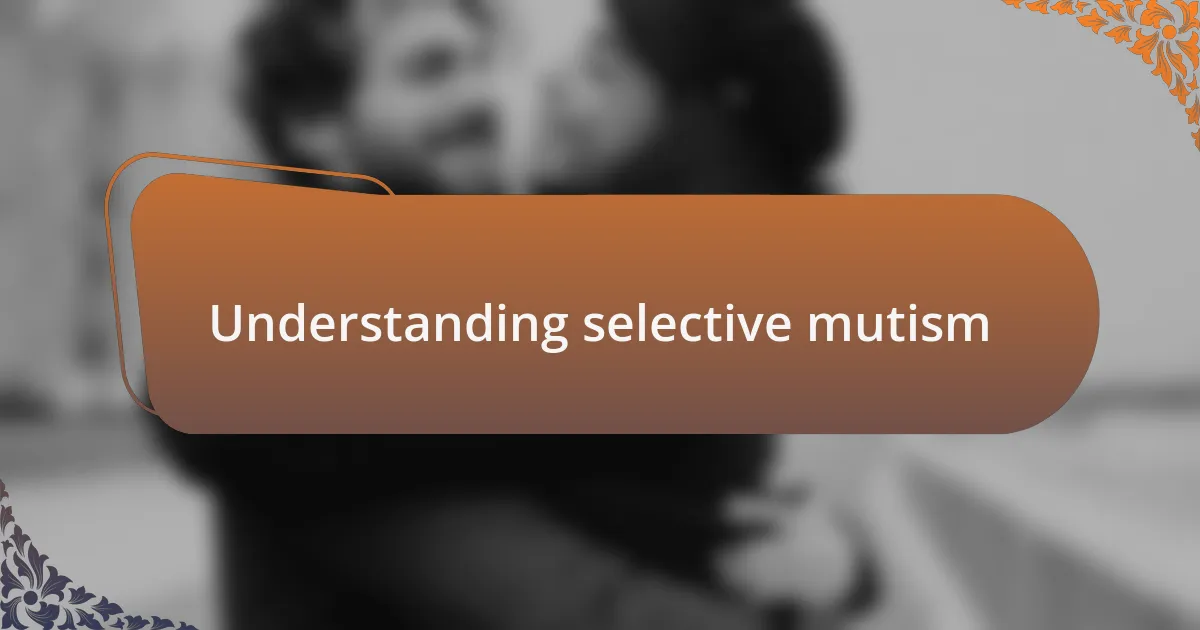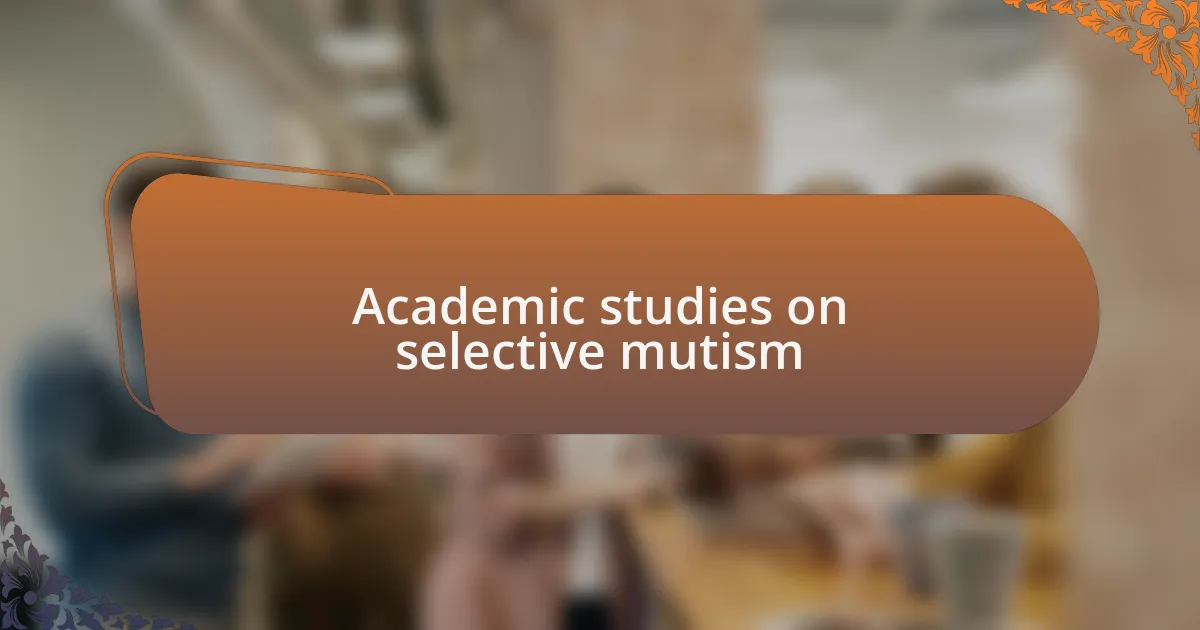Key takeaways:
- Selective mutism is an anxiety disorder impacting children’s ability to speak in specific social contexts, highlighting the need for a supportive environment.
- Awareness is crucial for fostering understanding and acceptance, as misconceptions can lead to isolation for affected children.
- Academic research emphasizes the connection between selective mutism and social anxiety, advocating for early intervention and tailored support to help children express themselves.
- Community engagement, storytelling, and workshops can effectively raise awareness and create empathetic spaces for those experiencing selective mutism.

Understanding selective mutism
Selective mutism is a complex anxiety disorder that primarily affects children’s ability to speak in certain social situations. I remember when I first learned about it; it struck me how silence can be so powerful and laden with unspoken feelings. Often, it’s not just a choice to remain silent but a manifestation of overwhelming anxiety. Have you ever felt so nervous that words seemed to evaporate from your mind?
Many children with selective mutism are often chatty at home yet become mute in school or with strangers. This contrast can leave parents and teachers bewildered. I encountered a case where a bright little girl would shy away from conversations in class, and her vibrant personality would dim as the teacher called on her. It made me reflect on how important it is to create a safe, nurturing environment for these children to express themselves.
Understanding selective mutism requires empathy and patience. It’s a reminder of how we cannot always see the struggles that others face. I often wondered, what if we could cultivate more compassionate spaces? Imagine the transformations we could witness when individuals feel safe to share their voices, free from judgment or fear.

Importance of awareness
Awareness of selective mutism is crucial for fostering understanding and support in our communities. When I first shared information about this disorder, I noticed how many people had misconceptions, believing children were simply shy or rude. This realization struck me—if we can simply educate ourselves, we can create a more inclusive environment where children no longer feel pressured to conform to societal expectations.
Considering the emotional weight carried by those with selective mutism, raising awareness leads to a culture of acceptance and kindness. I remember a heartbreaking moment when a parent told me their son felt isolated during recess because no one understood why he stayed quiet. This deep-rooted misunderstanding can lead to loneliness, making it even more vital for us to highlight why awareness matters—not just for the children, but for their families and peers as well.
Furthermore, spreading knowledge about selective mutism empowers those affected to seek help and share their experiences. Imagine if each classroom had resources and information available; it could open dialogues and diminish stigma. I’ve seen firsthand how awareness can transform a child’s experience—from being overlooked to feeling acknowledged—simply by helping those around them understand the quiet struggle they endure.

Academic studies on selective mutism
Academic studies on selective mutism have revealed crucial insights that shape our understanding of this complex condition. For instance, I came across research highlighting the link between selective mutism and social anxiety, illustrating how these children often grapple with overwhelming anxiety in social situations. This connection has helped me appreciate that it’s not merely a matter of shyness; rather, it’s a significant challenge that can deeply affect a child’s ability to engage with their environment.
One fascinating study I read discussed the effectiveness of various therapeutic approaches, such as cognitive-behavioral therapy (CBT) and gradual exposure techniques. I remember feeling relieved to know there are proven methods that empower children to find their voices, both literally and figuratively. Have you ever witnessed a child slowly opening up after receiving the right support? It’s a powerful reminder of how transformative these academic findings can be in practice.
Additionally, research emphasizes the importance of early intervention and tailored support strategies, which really resonates with me. When I think about the families I’ve spoken to, their stories often highlight the relief they felt when someone finally understood their child’s struggles. Knowing that academic studies advocate for early action reinforces the idea that we can make a difference in these children’s lives, fostering an environment where they can thrive without the shadows of selective mutism holding them back.

Personal experiences with selective mutism
Experiencing selective mutism as a child was like living in a world full of whispers while everyone else screamed. I vividly remember the first day of kindergarten—my heart raced as I stood frozen at the door, overwhelmed by the unfamiliar sounds and faces. I often wonder if anyone truly realizes how isolating it can feel to have something to say but be unable to voice it.
Throughout elementary school, I encountered a mix of understanding and confusion from my peers. One time, a classmate asked why I never spoke during group activities. In that moment, I felt both exposed and relieved—exposed because my struggle was out there, but relieved because it opened the door for a deeper conversation about my experiences. Have you ever had someone ask a question that abruptly forced you to confront your reality? It’s a daunting yet necessary experience.
As I grew older, the academic studies I encountered helped me navigate the complexities of my selective mutism. They offered insights that allowed me to communicate my feelings more openly with friends and family, transforming my silence into a bridge rather than a barrier. I can’t help but feel grateful for the researchers who laid the groundwork for understanding this condition, and I often think about how their findings have the potential to change lives. Can you imagine what it might have been like if I had access to this knowledge sooner?

Applying insights from studies
Applying insights from studies has transformed how I view my own experiences with selective mutism. For instance, I came across research indicating that children with this condition often feel immense pressure when faced with social interactions. Understanding this helped me to articulate my feelings better, and I started to embrace moments when I could communicate, even if it was just through writing or gestures. Have you ever found relief in knowing you weren’t alone in your struggles?
One particular study emphasized the role of supportive environments in overcoming selective mutism. This resonated with my own journey, especially when I think back to a teacher who created a safe space for us to share our thoughts. Her encouragement reminded me that we are all on our own unique paths, and having someone believe in you can make all the difference. I often reflect on how critical those nurturing moments were; do you recognize similar influences in your life?
The findings from these studies didn’t just stay in the realm of theory for me; they became practical tools. By applying concepts like gradual exposure to speaking situations, I began to push my boundaries, even if it was as simple as saying “hello” to a classmate. Each small step was a victory in my battle against silence, fueled by the knowledge that others have navigated this path too. I wonder how many people could find their voice if they had access to this kind of understanding sooner.

Strategies for raising awareness
Raising awareness about selective mutism can be greatly enhanced through community engagement and storytelling. I remember attending a local seminar where a young person shared their journey with selective mutism. Hearing their story resonated deeply with many in the room, showcasing the power of personal experience. Have you ever felt a connection through someone’s story that illuminated your own feelings?
Social media is another effective tool for spreading awareness. When I shared my experiences online, I was amazed at the response from others who related. It became clear that a simple post could inspire discussions and build a network of support. Isn’t it uplifting to see how sharing our challenges can foster community and understanding?
Hosting workshops focused on selective mutism can also provide invaluable education. I once participated in an interactive session where we role-played different communication situations. It not only educated participants but also created empathy among peers. Could we consider how such activities might change perceptions and create a safer space for those who feel unheard?